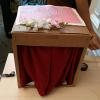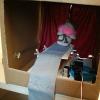Birdlesque
Description:
A very pretty bird peeps out on her stage when the curtains open. As the photocell in her hat senses that she is in the light, the LEDs in her bikini top turn on to attract attention, and she sings "La Vie en Rose." Her stage is propped up with wood and can be controlled using a servo motor.
Components:
- 1 box
- 1 crocheted bird
- pieces of felt and conductive thread
- 2 red LEDs
- 2 220-ohm resistors
- 1 photocell
- 1 10k-ohm resistor
- 1 piezo speaker
- 2 Arduino Unos
- 2 breadboards
- flat piece of balsa wood, plus supporting pieces to prop it up
- small pieces of balsa wood, acting as "arms"
- pins and tape to hold the wood together
- 2 pieces of t-shirt cotton for curtains
- 4 bobbins
- yarn (works with bobbins to make the curtain)
Code:
Photocell-controlled heartbeat-like blinking:
- Login to post comments



